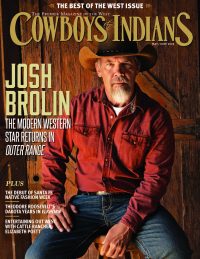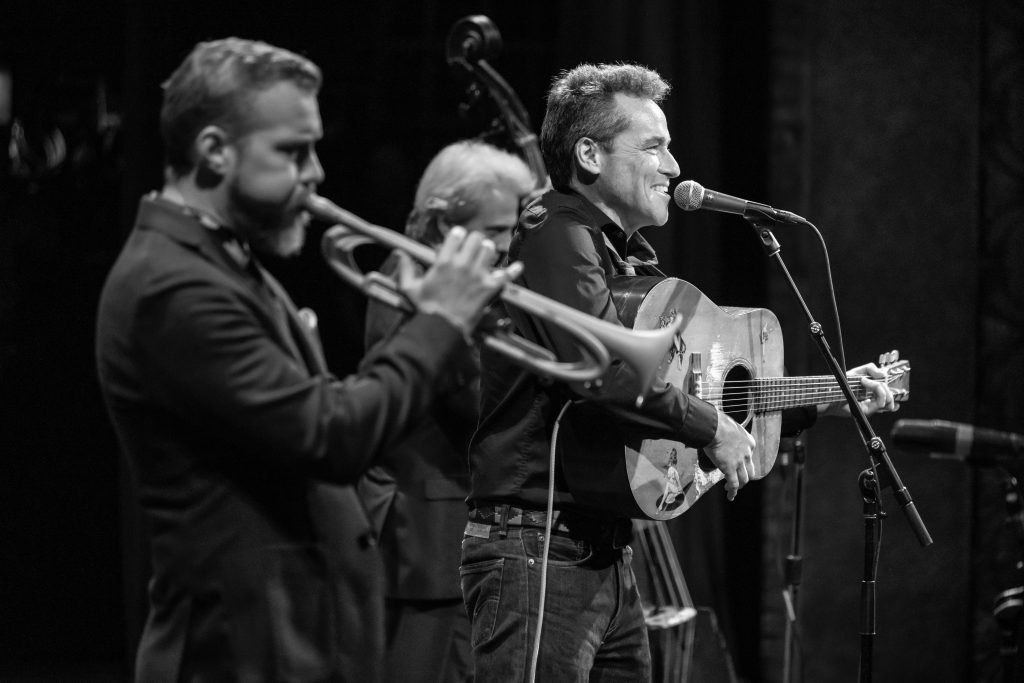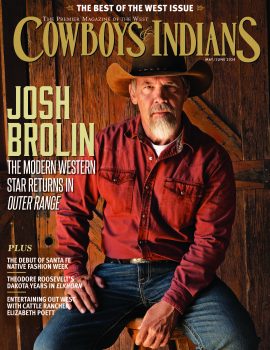We’ve got the first listen to the new song “Missing Us Most of All” by this Austin-based favorite, with a bonus: Monte Warden’s Feel Good Playlist.
Monte Warden has been a loved fixture on the Austin, Texas, music scene since he was a teen. At 15, he started playing local honky-tonks, then found an international following with the Wagoneers, and later landed a solo deal on a Nashville major label. After the Wagoneers disbanded, Warden had a songwriting hit with George Strait’s superb rendition of “Desperately.” After reuniting with the Wagoneers in 2011 for their Texas Music Hall of Fame induction, Warden, who was already inducted as a solo artist, realized he’d been missing the stage. He’s been delivering shows regularly with the Wagoneers since 2011 and with the Dangerous Few since 2016.
We talked with Warden about the new record, Monte Warden & The Dangerous Few, out June 19, and got the backstory on the song “Missing Us Most of All.”
Cowboys & Indians: We’re pleased to premiere your brand-new single, “Missing Us Most of All.” How did the song come together?
Monte Warden: This song is about the loss of a long-term relationship; while you do remain you, you’ll never be that “us” again. The inspiration came from a conversation Brandi had with Mas Palermo’s mother, Italia, about losing the love of your life. I was vamping on my ’54 Hofner and experimenting with some traditional pop and jazz chords when this melody seemed to present itself. As we were writing the lyrics, Brandi and I both found ourselves choking back tears at the thought of ever losing one another. When we were going through song selection for the album, this was one of [trumpeter and co-producer] Erik Telford’s cornerstones, saying it sounded like a jazz standard. The background vocals on the bridge kill me.
C&I: I’ve read that this new music sees you taking a step back from country. …
Warden: I wouldn’t say it’s a “step back” from country. It’s more of a step forward as a songwriter. With the intricate melody structures found in this genre, I’m able to more freely explore a diversity of lyrics that writing honky-tonk music doesn’t as easily provide.
C&I: Your “new” sound has been described as “martini music.” …
Warden: The songwriting, performances, vocal approach, and production were all laser-focused on achieving a sound and mood consistent with the optimism, sexiness, and sophistication so prevalent in midcentury modern fashion and lifestyle, which can more simply be broken down to the phrase martini music! We actually have a song called “Martini.” When we first started playing shows, new fans would come up and enthusiastically ask “What do you call this music?!” We described it as “martini music.” Brandi suggested we write a big, fun up-tempo ode to the martini, so we rode over to Floyd Domino’s house and all did our best to just get the hell outta this song’s way. It’s one of those rare little gems that seemed to write itself. That line “country club mosquitoes” had us all goin’ nuts. I can count on this song to always deliver a musical shovel-to-the-face at any gig.
C&I: If it’s kind of Fifties cocktail-lounge-y, it also sounds very slow-danceable. If you’ve had a chance to play anything from the new record live, what’s the action on the dance floor like?
Warden: We picked about 200 live shows before hitting the studio, so our audience was actually the very best A&R department with regard to what ultimately went on the album. The dance floor would be packed with couples of all ages and backgrounds, laughing, singing along (and making martini spectacles of themselves, particularly on “Here Kitty-Kitty”). We wanted to make sure the entire album would work perfectly at a swingin’ ’60s cocktail party.
C&I: Where is home for you? What kind of music did you grow up listening to that your parents played and that you absorbed? Any Dean Martin, Herb Alpert, Frank Sinatra?
Warden: I am blessed to live in my hometown of Austin, Texas. A fabulous place to grow up and live [because of] the openness and willingness of Austin’s audiences to give an artist the freedom to explore, hone, and expand their talents and sound.
My musical tastes were largely defined by what I first heard on television: Sinatra, Elvis, Glen Campbell, Dean Martin, etc. As I got a bit older, maybe 10 or 11, I was very much consumed by the records I bought or checked out from the library. My records were my best friends: Waylon Jennings, Buddy Holly, Everly Bros., Emmylou Harris, the Ramones, Rank and File, etc.
My affinity for Herb Alpert’s music began when I was 19 and he signed me to his record label, A&M Records.
C&I: You’ve said this record captures what you guys do when you play live, and, in fact, you recorded the new record in just two days, which is practically live in studio terms. What was the recording experience like with the band?
Warden: We were so blessed to have picked over 200 dates before recording. With Brandi co-producing the album, so much of our home life was one long preproduction meeting, meaning we could address every aspect of recording, keys, vocal phrasing, solo structure, etc. The only real challenge, which didn’t last longer than 15 minutes, was convincing co-producer Tim Palmer that we 100 percent had to be in the same room all recording live at the same time. Tim was brilliant in his use of physical baffles and separation — as producers had to use on recording sessions of the ’40s – ’60s.
C&I: The Dangerous Few is a group of ace Austin musicians. How did you come to know these guys? Had you played together before? What’s the synergy/energy like playing and recording together?
Warden: Our bassist, Brent Wilson, who also plays lead guitar for the Wagoneers, and I first met when I was 16 years old. Our drummer and co-producer, Mas Palermo, I’ve known since I was 20. He and I co-wrote one of the Wagoneers’ biggest hits, “Sit a Little Closer.” He also produced my first solo record and I was best man at his wedding, so our relationship goes well beyond the music. Our trumpeter and co-producer is Erik Telford; I’ve known and worked with him for 10 years and he was the first musician I asked to join the Dangerous Few. Pianist T Jarrod Bonta I only knew by reputation, but he fell in right away. These boys have a complete grasp, respect, and understanding of my vision for this project and the songs Brandi and I write. They do an amazing job of bringing these songs to life.
C&I: The album art is terrific. Tell us about that.
Warden: The artist is Derek Yaniger (DerekArt). Finding him was all Brandi. We were going through several books of ’50s/’60s art and contemporary graphic artists that are heavily influenced by midcentury modern and kept coming back to Derek’s amazing work. She reached out to him, and though he no longer was doing band art, we discovered he had been a big Wagoneers fan, so he jumped at the chance to do this project. We loved everything he sent, and, as he speaks in a heavy “hep-cat” vernacular, Brandi got back to him after he sent one draft and replied, “I’m a smitten kitten.” And that was the impetus for us writing “Here Kitty-Kitty.”
C&I: Are you going to be making music with both the Wagoneers and the Dangerous Few? How do those musical experiences compare?
Warden: Yes, I will continue to keep both projects busy. I even feel I could go on tour with both projects on the same bill (talk about something unique!). I am very proud of both bands and the statement their music makes. Obviously they are musically very different from one another as one is credited with helping start Americana music — the Wagoneers — and the other — the Dangerous Few — has a new, fresh sound that has not yet been fully defined. However, I write all the songs for both bands, [so] the emotions and expressions are all from the same heart.
C&I: Where have you been spending lockdown? Doing what?
Warden: Brandi, I, and our three sons have been blessed to enjoy good health. Brandi and I are both avid runners and have maintained access to our favorite running trails without interruption. We have continued to focus on the creative and have spent a good amount of our time preparing for the release of this album.
C&I: How did you manage to keep in touch musically with the band and fans during lockdown? Anything about the experience that you’ll be taking forward?
Warden: I started doing a live-stream every Friday at 7 p.m. Central called The Monte Warden Feel Good Hour on my Facebook page that has been a godsend and lifesaver for us, not just financially, but spiritually as well. I have been able to connect, stay connected, and reconnect with my fans in ways I never knew were available to me. I hope to continue to do the livestreams as long as the folks still seem to enjoy them.
C&I: Now that lockdown is partially lifting and slowly moving toward some kind of new normal, what are you looking forward to doing, in addition to getting out live in front of people with the new music?
Warden: Texas was one of the first spots to have restaurants reopen, so we have enjoyed a return to Tex-Mex food for a few weeks now. The music venues were among the first to close and will be among the last to reopen, so I will continue to look forward to pickin’ in front of folks as soon as I can — hopefully all over the world.
C&I: What might people be surprised to learn about you?
Warden: I have almost a photographic memory, but only on things I’ve read. If you tell it to me, it’s 60/40 against my remembering, but if I read it, t’s in the vault! I also have a potty mouth.
For more on Monte Warden, follow him on Facebook or Instagram, and follow the band on Facebook. To order music (vinyl, CD, digital, etc.), click here.
Monte Warden’s Feel Good Playlist
“Accentuate the Positive” — Bing Crosby
“Ain’t Livin’ Long Like This” — Waylon Jennings
“Blitzkrieg Bop” — The Ramones
“White Lightnin’” — George Jones
“Everyday” — Buddy Holly
“High Hopes” — Frank Sinatra
“Mystery Train” — Elvis Presley
“Beyond the Sea” — Bobby Darin
“We Got the Beat” — The Go-Go’s
“Gentle on My Mind” — Glen Campbell
“Martini” — The Dangerous Few
“Stout & High” — The Wagoneers
Photography: Images courtesy Matt Sturtevant and Sean Mathis













